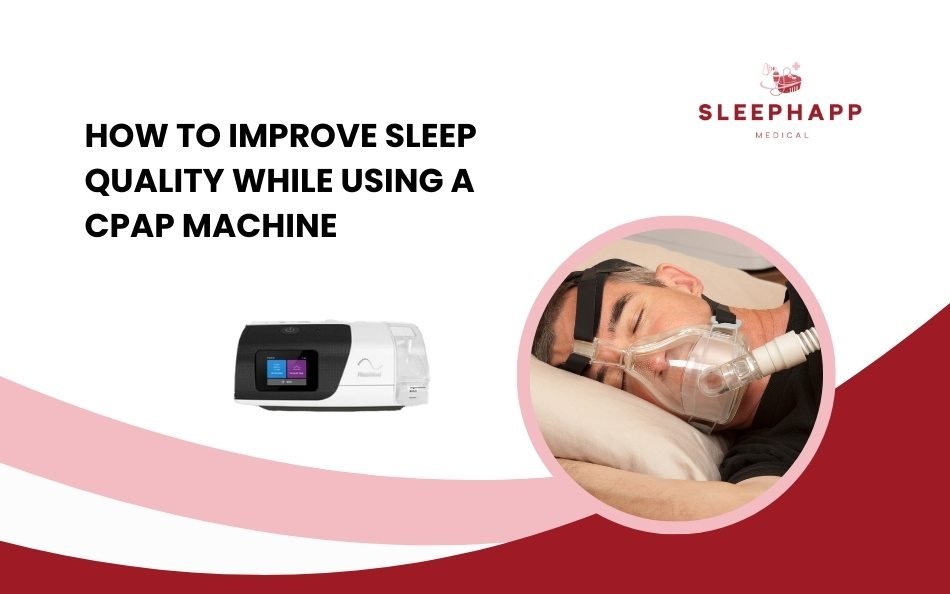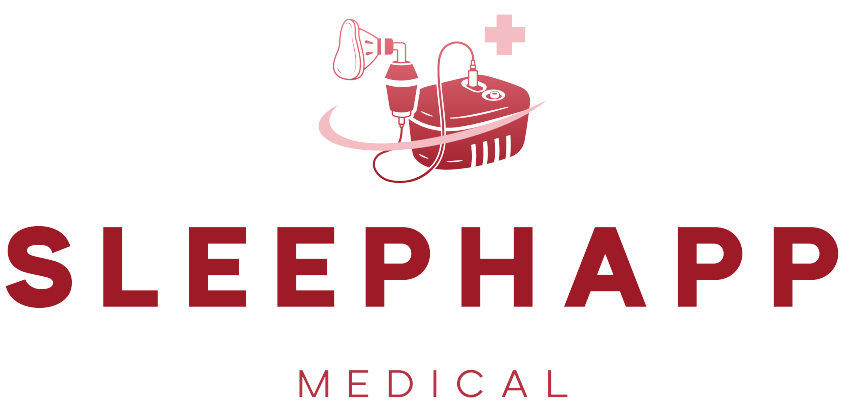How to Improve Sleep Quality While Using a CPAP Machine
Home » How to Improve Sleep Quality While Using a CPAP Machine

Table of Contents
Continuous Positive Airway Pressure (CPAP) therapy is a good treatment for obstructive sleep apnea (OSA). But many people find it hard to get used to the machine. This can make sleep worse.
You can sleep better by fixing common problems and using the CPAP machine correctly. Below is a simple guide to help you rest well with a CPAP machine.
Ensure Proper Mask Fit
Select the Right Mask Type
The mask is the most essential part of your CPAP machine. Choosing the right mask can help you sleep better and feel more comfortable.
There are three main types of CPAP masks:
- Nasal masks – These cover your nose. They are good if you breathe through your nose.
- Nasal pillow masks – These are small and fit inside your nostrils. They feel less bulky.
- Full-face masks – These cover your nose and mouth. They are best if you breathe through your mouth or have a stuffy nose.
Choose a mask that fits your breathing style and feels comfortable.
Check for Leaks
If the mask does not fit well, air can leak, making CPAP therapy less adequate and disturbing sleep. Make sure the mask straps are snug but not too tight. Tight straps can hurt and irritate the skin.
Most new CPAP machines have a mask seal test. This test helps you find leaks. Adjust the mask until the machine shows a good seal.
Replace Worn-Out Components
CPAP mask parts like cushions, headgear, and seals can wear out, causing leaks and discomfort. To keep the mask working well and clean, replace them as the manufacturer suggests, usually every 3-6 months. For more details check out this Philips Sleep and Respiratory Care.
Optimize CPAP Machine Settings
Adjust Pressure Settings
Your CPAP machine’s air pressure is significant. It keeps your airway open.
- If the pressure is too low, it won’t work well.
- If the pressure is too high, it may feel uncomfortable.
Talk to your sleep doctor to set the correct pressure. Many CPAP machines have an auto-CPAP mode. This mode changes the pressure based on your breathing.
Use the Ramp Feature
The ramp feature helps you fall asleep quickly. It starts with low pressure and slowly increases to the set level. This is useful for new CPAP users who may initially find high pressure uncomfortable.
Enable Expiratory Pressure Relief (EPR)
Breathing out against high air pressure can feel uncomfortable. Expiratory Pressure Relief (EPR) lowers the pressure when you exhale, making breathing more natural. It also helps improve comfort and makes it easier to follow the therapy. Learn more about Expiratory Pressure Relief (EPR).
Improve Comfort and Adaptation
Practice Daytime Wear
Wearing your CPAP mask during the day while reading or watching TV can help you get used to the sensation. This practice reduces anxiety and makes nighttime use feel more natural.
Experiment with Sleeping Positions
Your sleeping position can affect how well your mask stays in place. Side sleeping is often recommended to reduce mask displacement and improve airflow. Use pillows to maintain a comfortable side-sleeping position.
Wear Comfortable Accessories
Mask liners and padded straps can minimize skin irritation and improve comfort. These accessories are beneficial for users with sensitive skin.
Address Side Effects
Combat Dryness
CPAP therapy can make your mouth or nose dry. A heated humidifier adds moisture to the air and helps. You can also use nasal saline sprays or safe moisturizers.
Reduce Nasal Congestion
A blocked nose can make CPAP therapy hard. You can use antihistamines or nasal sprays to help. But ask your doctor before using them often.
Prevent Skin Irritation
Wash your mask every day with mild soap and water. This stops bacteria from growing. Bacteria can make your skin itchy or red. Do not use strong chemicals. They can damage the mask.
Enhance Sleep Hygiene
Maintain a Consistent Sleep Schedule
Go to bed and wake up at the same time every day. This helps your body’s internal clock. It improves your sleep quality.
Create a Relaxing Bedtime Routine
Avoid screens, caffeine, and heavy food before sleep. Do calming things like reading or meditation. This will help your body prepare for sleep.
Optimize Sleep Environment
Keep your bedroom cool, dark, and quiet. Use blackout curtains to block light. A white noise machine can help with sound. Earplugs can also make it more peaceful. This will help you sleep better.
Regular Equipment Maintenance
Clean Your CPAP Parts Daily and Weekly
Wash your CPAP mask, tubing, and humidifier chamber to prevent bacteria from growing. This will help your CPAP work well.
- Daily Cleaning: Use mild soap and water.
- Weekly Deep Cleaning: Use a vinegar and water mix.
Keep your CPAP clean for better health and sleep!
Replace Filters and Parts
Change filters, hoses, and masks as the manufacturer says. Replacing them often stops problems and keeps the air clean.
Monitor Progress
Track Data via CPAP Software
Most new CPAP machines can track data. They check things like AHI scores and leak rates. Use this data to see if your therapy works, and change settings if needed.
Journal Symptoms
Keep a journal to track symptoms like daytime sleepiness, snoring, or morning headaches. This can help identify patterns and areas for improvement.
Consult Healthcare Providers
Schedule regular check-ups with your sleep doctor. This helps fix problems and adjust your CPAP settings. Health issues like allergies, obesity, or GERD can make CPAP less effective. Treating these can improve your sleep.
More Tips for Better Sleep
Sleep on Your Side
If you sleep on your back, try using a unique shirt to help you sleep on your side. This can stop snoring.
Adjust Humidity
Change your humidifier’s settings based on the weather. This keeps your room comfortable.
Relax Before Bed
Try deep breathing or meditation before sleep. This can help you feel calm and sleep better.
Conclusion
Sleeping well with a CPAP machine needs care, good habits, and help from doctors. Keep your CPAP clean and use it correctly. Fix any problems to make it work better. This will help you sleep peacefully without trouble. Stay patient and use it every night to get the best results.
Sources:
- https://www.sleepfoundation.org/cpap/how-to-use-cpap-machine
- https://www.resmed.com/en-us/sleep-apnea/cpap-products/cpap-machines/
- https://www.usa.philips.com/healthcare/solutions/sleep-and-respiratory-care
- https://www.resmed.com/en-us/sleep-apnea/sleep-blog/living-with-cpap-7-tips-for-a-better-experience/
